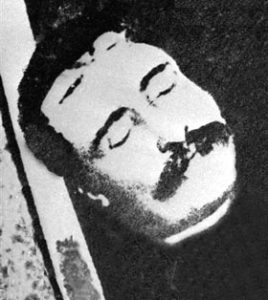It could be called Robin Hood or Jesse James, Jesuíno Brilhante or Cartouche. Fra Diábolo or El Tempranillo. The truth is that in the folklore of each nation appears the phenomenon of banditry. So far back is the matter that, for some historians, Procchio and the well-known Caco were but renowned bandits of the ancient world.
The scheme repeats itself from town to town: as the folklorists of all latitudes attest, the popular legend of the “noble” bandit is a constant. Protector of widows and orphans, defector of misfortunes that robs the affluent for the benefit of the needy; Is the good man who, forced by society, circumstances and misery, is compelled to become an outlaw.
Maria de las Mercedes Santa Cruz, the Havana Countess of Merlin, recorded, in 1844, the presence of the phenomenon in Cuba. His description fits perfectly with the aforementioned scheme of the “noble” bandit: “He who kills another flees to the interior of the Island, is pursued and puts a price on his head. Abandoned as an enemy of the human species, forced to fear and defend himself, he becomes a thief to provide for his existence, and a murderer to keep it. But in the midst of this degradation most of them retain a certain adventurous and chivalrous spirit which is not devoid of generosity. ”
In the list of Cuban bandits we find Victoriano Machin and Ulloa, famous for his sensational escape from the Prince’s Castle. Recaptured, he married his concubine Simeona, before suffering pain from a club in 1888.
José Moreno y Suárez, Machin’s partner, was the father of 27 children. Such was his popularity that the frightened Spanish authorities to transfer him to Guanajay, place of the execution, prepared a train with a custody of 200 soldiers. From the scaffold he shouted, “This is over. Goodbye, gentlemen! ”
He assures himself of Cristóbal Fernández Delgado, a bandit of Jovellanos, who, like Marie-Antoinette, totally shrouded the night before the execution.
But when banditry reached legendary dimensions among us, it was with Manuel García, the “King of the Fields of Cuba,” who has been considered “the most firm and popular figure of our folklore.”
Suffice it to say that while he was still alive a danzón with his name was sung. After being buried it would inspire a silent film, another sound, comics, radial episodes that extended for years and journalistic polemics that from time to time grabbed the attention of the readers.
A controversial figure, for some it was patriot courage; For others, vulgar bandit. The truth is that he was killed by treason, with a revolver shot in the back, the very February 24, 1895, when he was presumably ready to back the uprising.
That elucidate the truth of the Cuban Robin Hood other colleagues with more brains and patience, because this humble gazelle does not catch the breath for so much.
Convertido en Leyenda Manuel García “El Rey de los Campos de Cuba”.
Pudo llamarse Robin Hood o Jesse James, Jesuíno Brilhante o Cartouche. Fra Diábolo o El Tempranillo. Lo cierto es que en el folklore de cada nación aparece el fenómeno del bandolerismo. Tan atrás se remonta el asunto que, para algunos historiadores, Procusto y el archiconocido Caco no fueron más que renombrados bandoleros del mundo antiguo.
https://youtu.be/s06oPIMboQ0
El esquema se repite de pueblo a pueblo: como atestiguan los folklorólogos de todas las latitudes, la leyenda popular del bandolero “noble” constituye una constante. Protector de viudas y huérfanos, desfacedor de entuertos que despoja a los pudientes en beneficio de los menesterosos; es el hombre bueno que, obligado por la sociedad, las circunstancias y la miseria, se ve compelido a convertirse en un fuera de la ley.
María de las Mercedes Santa Cruz, la habanera Condesa de Merlín, dejó constancia, en 1844, de la presencia del fenómeno en Cuba. Su descripción cuadra perfectamente con el mencionado esquema del bandolero “noble”: “El que mata a otro huye al interior de la Isla, se le persigue y se pone precio a su cabeza. Abandonado como enemigo de la especie humana, obligado a temer y a defenderse, se hace ladrón para proveer su existencia, y asesino para conservarla. Pero en medio de esta degradación suelen conservar los más de ellos cierto espíritu aventurero y caballeresco que no está desprovisto de generosidad”.
En la nómina de los bandoleros cubanos hallamos a Victoriano Machín y Ulloa, célebre por su sensacional evasión del Castillo del Príncipe. Recapturado, se casó con su concubina Simeona, antes de sufrir pena de garrote en 1888.
José Moreno y Suárez, compañero de Machín, era padre de 27 hijos. Fue tal su popularidad que las atemorizadas autoridades españolas para trasladarlo a Guanajay, lugar de la ejecución, prepararon un tren con una custodia de 200 soldados. Desde el patíbulo gritó: “Se acabó esto. ¡Adiós, caballeros!”.
Se asegura de Cristóbal Fernández Delgado, bandolero de Jovellanos, que, como María Antonieta, encaneció totalmente durante la noche anterior al ajusticiamiento.
Mas, cuando el bandolerismo alcanzó entre nosotros dimensiones de leyenda fue con Manuel García, el “Rey de los Campos de Cuba”, quien ha sido considerado como “la figura más firme y popular de nuestro folklore”.
Baste decir que cuando aún estaba en vida se cantaba un danzón con su nombre. Después de enterrado inspiraría una película silente, otra sonora, comics, episodios radiales que se extendían por años y polémicas periodísticas que cada cierto tiempo acaparaban la atención de los lectores.
Personaje controvertido, para unos fue corajudo patriota; para otros, vulgar bandido. Lo cierto es que resultó muerto a traición, de un tiro de revólver por la espalda, el mismísimo 24 de febrero de 1895, cuando presumiblemente se disponía a secundar el alzamiento.
Que diluciden la verdad del Robin Hood cubano otros colegas con más seso y paciencia, pues a este humilde gacetillero no le alcanza el aliento para tanto.
Agencies/CubaAhora/Argelio Santiesteban/Internet Photos/ Arnoldo Varona/ TheCubanHistory.com
THE CUBAN HISTORY , HOLLYWOOD.







